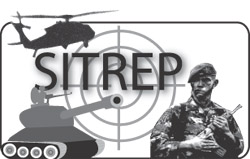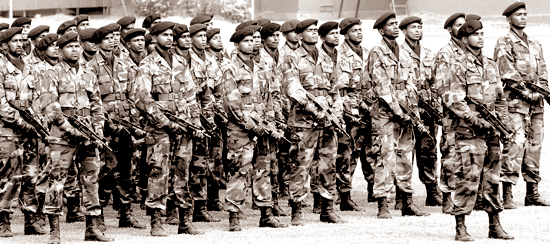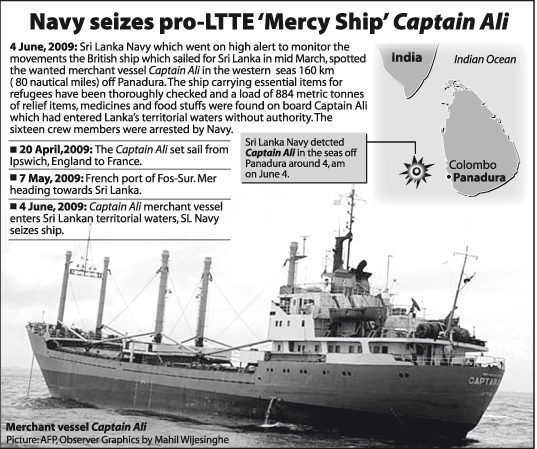|
Fight against false propaganda on SL victory still
on:
Powerful defence structure to eliminate any internal and external
threats
|

by Ranil WIJAYAPALA |
 Sri
Lanka’s fight against brutal LTTE terrorism is now over. The
celebrations to mark that magnanimous victory is also coming to an end
with President Mahinda Rajapaksa announcing a massive development drive
to make Sri Lanka the pride of Asia at the National Victory Parade to
salute the war heroes who made it a reality. Sri
Lanka’s fight against brutal LTTE terrorism is now over. The
celebrations to mark that magnanimous victory is also coming to an end
with President Mahinda Rajapaksa announcing a massive development drive
to make Sri Lanka the pride of Asia at the National Victory Parade to
salute the war heroes who made it a reality.
Despite all these celebrations, the battle between the falsehood and
the truth on Sri Lanka’s victory is still on as many of the western
nations and so-called Human Rights organizations are calling for an
investigation on human rights violations by the Sri Lankan Government
and the Security Forces against the Tamil community in the last phase of
the battle to rescue the civilians detained by the LTTE.
It is appalling to observe that some media personnel are forcing some
UN officials to obtain answers to illusions they were chasing behind,
under the influence of Tiger operatives still living among nearly one
million strong Sri Lankan Tamil Diaspora across the globe, unaware of
the fact that they have become contractors of the LTTE proxies to bring
disrepute to the Sri Lankan Government at this historic moment.
It is also pathetic to note that none of those so-called media
personnel are interested in learning the sacrifices made by the Sri
Lankan Security Forces, but want to dig into to unknown and non-existing
graves of 20,000 civilian deaths they have calculated according their
own assumptions.
They are going behind this myth of 20,000 civilian deaths and
spreading wild rumours to push the UN to conduct investigations into
those myths. Even the UN officials have been embarrassed by the false
media reports by the `London Times’ quoting UN sources and documents
even the UN officials were unaware of.
The objectives of all these attempts were to come out of the
humiliating situation the Western nations faced at the United Nations
Human Rights Council special session on Sri Lanka. The correct answer to
this attempts made by the West with strong backing from the High
Commissioner for Human Rights, Navanethem Pillay, to ignore the
resolution adopted on an inter-governmental decision from non other than
India’s Permanent Representative to the UN in Geneva A. Gopinath.
“It would be extremely unfortunate if inter-governmental decisions
adopted by the Human Rights Council were to be ignored or set aside, and
the High Commissioner and/or her office were to misinterpret them or
wilfully neglect them or supersede them,” Gopinath told the UN Human
Rights Council expressing the concern of the Indian delegation to the
UNHRC with regard to the remarks made by the High Commissioner on Sri
Lanka and the recently concluded Special Session, in her statement.
“The High Commissioner and her office would be fully aware of the
discussions and negotiations on the different elements of the outcome
and on the positions adopted by different member states and groupings on
these elements.
It is important to recall and reaffirm that the outcome of the
Special Session reflects an inter-governmental decision adopted
according to the Rules of Procedure of the Council. What is more, it
endorses the joint communique issued at the end of the recent visit to
Sri Lanka by the UN Secretary-General which, among other things,
reaffirms the willingness of the Government of Sri Lanka to address the
issues of accountability in response to the concerns expressed by the UN
Secretary-General in this regard.
 “We
feel that in these circumstances, it would be prudent to adhere to the
outcome of the Special Session and be sensitive to the concerns
expressed already, rather than take a position on contested proposals or
controversial issues and ideas which did not find eventual acceptance in
the outcome of the Special Session”, Gopinath told the UNHRC. It is
interesting to note that the nations, who had a genuine understanding
about the Sri Lankan situation are still backing the Sri Lankan
Government at each and every forum as they were aware of the correct
situation in Sri Lanka and the challenges the Sri Lankan Government had
to face in its efforts to eliminate LTTE terrorism and in the aftermath. “We
feel that in these circumstances, it would be prudent to adhere to the
outcome of the Special Session and be sensitive to the concerns
expressed already, rather than take a position on contested proposals or
controversial issues and ideas which did not find eventual acceptance in
the outcome of the Special Session”, Gopinath told the UNHRC. It is
interesting to note that the nations, who had a genuine understanding
about the Sri Lankan situation are still backing the Sri Lankan
Government at each and every forum as they were aware of the correct
situation in Sri Lanka and the challenges the Sri Lankan Government had
to face in its efforts to eliminate LTTE terrorism and in the aftermath.
The other important issue raised by the international media is about
the missing people among the displaced civilians and they are trying to
highlight that nearly 10,000 people are missing from the welfare camps.
It is regretted to note that they are making those allegations based on
the facts given by those pro-LTTE organizations who are trying to
disturb the smooth handling of the displaced civilians.
But they were also not aware of the fact that nearly 10,000 ex -Tiger
cadres and recruits who arrived in Government controlled areas along
with the civilians, had surrendered to the Security Forces and were
separated from their families to be rehabilitated and another section of
civilians released to their close relatives.
The local media has given extensive coverage about the LTTE cadres
and recruits surrendered to the Security Forces and the way they were
kept separately from their families for rehabilitation purposes. The
important issue here is that those who were raising those questions were
not aware of the difficulties the Sri Lankan Government and the Security
Forces had undergone to make this victory a reality.
Even at this moment they should realize the fact that Sri Lankan
authorities cannot leave any room for this terrorist organization to
raise its ugly head again to draw the country again to a war. So they
should take all precautionary measures at identifying all the LTTE
activists among those civilians and rehabilitate them and reintegrate
them into society as normal civilians. The international community has a
bigger role to play in this regard.Therefore, it is regrettable to note
that some international media are trying to mislead the international
community through their misleading publications without verifying the
facts and figures they received from their sources. Ultimately, it has
become a question regarding the ethics followed by those media personnel
in the Western countries as they have become paranoid to the information
issued by the government authorities and relying on sources who never
exist in reality.So, the battle between the false propaganda about the
Security Forces victory against the most ruthless terrorist outfit, will
continue further until those so-called media personnel understand the
ground realities in Sri Lanka. As Sri Lanka is still fighting the false
media campaign at international level, the Security Forces are now ready
to shape up its role to face the future challenges that may arise in the
time to come. As Army Commander General Sarath Fonseka states, the
national policies of Sri Lanka should be changed to face the new threats
on national security that might emerge externally towards Sri Lanka.
In the post -independent Sri Lanka, the Security Forces were
established to handle disasters and uneasy situations among the general
public and to handle the public a protest against the Governments. It
was during the 1970 JVP insurrection that then Government under the
leadership of Prime Minister Sirimavo Bandaranaike purchased weapons
from China and strengthened the Army to a certain extent to check the
rebels.However, the strength of the Sri Lanka Army and also the Police
was not enough to face the situation created by the LTTE in the Jaffna
peninsula in the early 1980’s as the Sri Lanka Army had only four
regular battalions to handle the situation. The Police also had to close
their Police stations in the peninsula after the Chavakachcheri Police
station came under the attack of the LTTE in October 1982. The Sri
Lankan Security Forces and the Police could not handle the situation in
early 1980’s as they were not prepared to face such a challenging
situation during that time. The Sri Lanka Army had only four regular
infantry battalions with it when the LTTE launched its terror campaign
against the Sri Lankan Government. The strength of the Sri Lanka Army
was less than 10,000 at the time LTTE went on the rampage in Jaffna
peninsula.
It was due to the lapses in the National Security policy the entire
nation had to face the tragic war in this country for nearly three
decades that allowed the LTTE to turn its rebel force into a
conventional force by the end of 1990’s and to develop separate Wings
for sea and air operations and expand its operations all over the
country.
The Sri Lanka Army had to shift its battalions from one location to
another to face the LTTE and it was more like reactive approach to the
problem rather than a pro-active approach to eliminate LTTE. That was
why any successive government could not win the war against the LTTE at
any stage as they lacked a correct vision how to tackle this problem. On
the other hand, they feared to have a militaristic approach to the
problem fearing reactions from the international community. The success
behind the present military strategy was due to the expansion of the
three Forces with the recruitment of youth in massive numbers. The
biggest expansion took place in the Sri Lanka Army with the increase of
the strength from 116,000 in the year 2006 to 200,000 in the year 2009
to win this war.
Even with this magnanimous victory the Sri Lankan Security Forces
cannot stop the recruitment of youth to the Security Forces as the
National Security policies should be adopted to face the emerging
external threat to the country.
Though LTTE is eliminated fully from the country, the LTTE is still
active internationally as Kumaran Pathmanadan and many other LTTE
activists are operating worldwide to campaign against the Sri Lankan
Government . Therefore, possibilities cannot be ruled out about an
external threat to the country from the Tiger cadres operating
internationally. Like Maldivian Government faced such a threat in 1988
with the mercenaries from the PLOTE trying to oust then Maldivian
administration, Sri Lanka should also prepare its forces to face any
threat emerging externally. Defence authorities are now planning to keep
a considerable reserve with all three Forces, both in the Regular and
the Volunteer Forces to face any emerging threat. Therefore, the three
Forces are expected to recruit more and more youth to the three Forces
to strengthen their manpower and also their fire power to face any
eventuality despite crushing the LTTE.
The defence authorities are also now in the process of changing the
commanding structure of the three Armed Forces empowering more powers to
the Chief of Defence Staff to take all decisions regarding the
recruitment, intelligence, career planning, all operations and
structural changes in the three Forces and the operational matters of
the Police Department and the Civil Security Department.
Currently the Chief of Defence Staff is handling only coordination
between the three Forces and Police. With the empowerment of all these
powers to the Chief of Defence Staff he will be empowered to command all
three Forces and create a powerful defence structure deviating from the
current commanding structure of the three Forces.
This is aimed at taking quicker action to settle uneasy situations in
the country and to face any internal or external threats faster than the
present system of commanding as it provides a centralized command
structure with the formation of this powerful position. The Defence
Ministry is in the process of formulating these changes and will issue a
special gazette notification regard to these changes very soon before
the appointment of a new Chief of Defence Staff among the three Force
Commanders who commanded the Forces personnel to achieve this victory of
totally eliminating the LTTE from the Sri Lankan soil.
That would lay a strong foundation for the Sri Lankan Security Forces
to face any internal and external threat and facilitate the speedy
development drive proposed by President Mahinda Rajapaksa to make Sri
Lanka Asia’s pride very shortly. |

